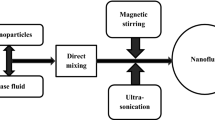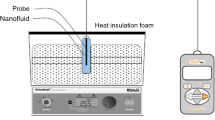Abstract
A pioneer idea for increasing the thermal performance of heat transfer fluids was the use of ultrafine solid particles suspension in the basefluid. Nanofluids, synthesized by mixing solid nanometre-sized particles at low concentrations with the basefluid, were used as a new heat transfer fluid which developed a remarkable effect on the thermophysical properties and heat transfer coefficient. For any nanofluid to be usable in heat transfer applications, the main concern is its long-term stability. In this investigation, pentaethylene glycol-treated graphene nanoplatelets (PEG-GnP), pentaethylene glycol-thermally treated graphene (PEG-TGr), Al2O3 and SiO2 were synthesized. The thermophysical properties of PEG-GnP, PEG-TGr, Al2O3 and SiO2 were measured experimentally by using different devices and equipment. Dispersion stabilities of carbon-based nanofluids and metallic oxides nanofluids were observed for 30 days, and the results showed the higher dispersibility of the nanofluids in an aqueous media with very low sedimentation. Thermal conductivity, viscosity and density were increased, while specific heat decreased as mass concentration increased. The temperature effect on the nanofluids was directly proportional to their thermal conductivity and inversely to the viscosity, density and specific heat.

















Similar content being viewed by others
Abbreviations
- Al2O3 :
-
Aluminium oxide
- AlCl3 :
-
Aluminium chloride
- CNT:
-
Carbon nanotubes
- Cp:
-
Specific heat capacity, J kg−1 K−1
- CuO:
-
Copper oxide
- DI:
-
Deionized water
- DMF:
-
Dimethylformamide
- DSC:
-
Differential scanning calorimetry
- EG:
-
Ethylene glycol
- Fe3O4 :
-
Iron oxide
- GnP:
-
Graphene nanoplatelets
- HCl:
-
Hydrochloric acid
- PEG:
-
Pentaethylene glycol
- SiO2 :
-
Silicon dioxide
- TGr:
-
Thermally treated graphene
- THF:
-
Tetrahydrofuran
- TiO2 :
-
Titanium dioxide
- UV–Vis:
-
Ultraviolet–visible spectroscopy
- ZnO:
-
Zinc oxide
- ρ:
-
Density, Kg m−3
- k:
-
Thermal conductivity, W m−1 K−1
- µ:
-
Dynamic viscosity, mPa s
References
Hemmat Esfe M, Esfandeh S, Rejvani M. Modeling of thermal conductivity of MWCNT-SiO2 (30:70%)/EG hybrid nanofluid, sensitivity analyzing and cost performance for industrial applications. J Therm Anal Calorim. 2017;131:1437–47.
Bashirnezhad K, Rashidi MM, Yang Z, Bazri S, Yan WM. A comprehensive review of last experimental studies on thermal conductivity of nanofluids. J Therm Anal Calorim. 2015;122:863–84.
Shanbedi M, Amiri A, Zeinali Heris S, Eshghi H, Yarmand H. Effect of magnetic field on thermo-physical and hydrodynamic properties of different metals-decorated multi-walled carbon nanotubes-based water coolants in a closed conduit. J Therm Anal Calorim. 2018;131:1089–106.
Yazid MNAWM, Sidik NAC, Yahya WJ. Heat and mass transfer characteristics of carbon nanotube nanofluids: a review. Renew Sustain Energy Rev. 2017;80:914–41.
Razali AA, Sadikin A, Ayop SS. Structural analysis and morphological study of Al2O3 nanofluids in microchannel heat sink. J Adv Res Fluid Mech Therm Sci. 2018;46:139–46.
Su Y, Gong L, Chen D. Dispersion stability and thermophysical properties of environmentally friendly graphite oil-based nanofluids used in machining. Adv Mech Eng. 2016;8:1–11.
Choi SUS, Eastman JA. Enhancing thermal conductivity of fluids with nanoparticles. ASME Int Mech Eng Congr Expo. 1995;66:99–105.
Baheta AT, Oumer AN, Hailegiorgis SM. Analysing the thermal performance of heat pipe using copper nanofluids. J Adv Res Fluid Mech Therm Sci. 2018;45:149–55.
Estellé P, Halelfadl S, Maré T. Thermophysical properties and heat transfer performance of carbon nanotubes water-based nanofluids. J Therm Anal Calorim. 2017;127:2075–81.
Leong KY, Razali I, Ku Ahmad KZ, Ong HC, Ghazali MJ, Abdul Rahman MR. Thermal conductivity of an ethylene glycol/water-based nanofluid with copper-titanium dioxide nanoparticles: an experimental approach. Int Commun Heat Mass Transf. 2018;90:23–8.
Abubakar SB, Sidik NAC, Ahmad AS. The use of Fe3O4–H2O4 nanofluid for heat transfer enhancement in rectangular microchannel heatsink. J Adv Res Mater Sci. 2016;23:15–24.
Nabil MF, Azmi WH, Hamid KA, Mamat R. Experimental investigation of heat transfer and friction factor of TiO2–SiO2 nanofluids in water:ethylene glycol mixture. Int J Heat Mass Transf. 2018;124:1361–9.
Liew PJ, Shaaroni A, Razak JA, Bakar MHA. Comparison between carbon nanofiber (CNF) nanofluid with deionized water on tool life and surface roughness in turning of D2 steel. J Adv Res Fluid Mech Therm Sci. 2018;46:169–74.
Amiri A, Shanbedi M, Chew BT, Kazi SN, Solangi KH. Toward improved engine performance with crumpled nitrogen-doped graphene based water-ethylene glycol coolant. Chem Eng J. 2016;289:583–95.
Yarmand H, Gharehkhani S, Shirazi SFS, Amiri A, Alehashem MS, Dahari M, et al. Experimental investigation of thermo-physical properties, convective heat transfer and pressure drop of functionalized graphene nanoplatelets aqueous nanofluid in a square heated pipe. Energy Convers Manag. 2016;114:38–49.
Amiri A, Shanbedi M, Ahmadi G, Eshghi H, Chew BT, Kazi SN. Microwave-assisted direct coupling of graphene nanoplatelets with poly ethylene glycol and 4-phenylazophenol molecules for preparing stable-colloidal system. Colloids Surf A Physicochem Eng Asp. 2015;487:131–41.
Ambreen T, Kim MH. Heat transfer and pressure drop correlations of nanofluids: a state of art review. Renew Sustain Energy Rev. 2018;91:564–83.
Yang L, Xu J, Du K, Zhang X. Recent developments on viscosity and thermal conductivity of nanofluids. Powder Technol. 2017;317:348–69.
Tawfik MM. Experimental studies of nanofluid thermal conductivity enhancement and applications: a review. Renew Sustain Energy Rev. 2017;75:1239–53.
Jabbari F, Rajabpour A, Saedodin S. Thermal conductivity and viscosity of nanofluids: a review of recent molecular dynamics studies. Chem Eng Sci. 2017;174:67–81.
Murshed SMS, Estellé P. A state of the art review on viscosity of nanofluids. Renew Sustain Energy Rev. 2017;76:1134–52.
Wang L, Wang Y, Yan X, Wang X, Feng B. Investigation on viscosity of Fe3O4 nanofluid under magnetic field. Int Commun. Heat Mass Transf. 2016;72:23–8.
Zafarani-Moattar MT, Shekaari H, Munes-Rast R, Majdan-Cegincara R. Stability and rheological properties of nanofluids containing ZnO nanoparticles, poly(propylene glycol) and poly(vinyl pyrrolidone). Fluid Phase Equilib. 2015;403:136–44.
Kumar M, Sawhney N, Sharma AK, Sharma M. Thermo-physical profile of zinc oxide nanoparticles dispersed in aqueous solution of propylene glycol. J Mol Liq. 2018;249:650–8.
Kumar V, Tiwari AK, Ghosh SK. Effect of chevron angle on heat transfer performance in plate heat exchanger using ZnO/water nanofluid. Energy Convers Manag. 2016;118:142–54.
Li Y, Fernández-Seara J, Du K, Pardiñas ÁÁ, Latas LL, Jiang W. Experimental investigation on heat transfer and pressure drop of ZnO/ethylene glycol-water nanofluids in transition flow. Appl Therm Eng. 2016;93:537–48.
Amiri A, Shanbedi M, Ahmadi G, Eshghi H, Kazi SN, Chew BT, et al. Mass production of highly-porous graphene for high-performance supercapacitors. Sci Rep. 2016;6:32686.
Lu PJ, Fu WE, Huang SC, Lin CY, Ho ML, Chen YP, et al. Methodology for sample preparation and size measurement of commercial ZnO nanoparticles. J Food Drug Anal. 2018;26:628–36.
Chamkha AJ, Molana M, Rahnama A, Ghadami F. On the nanofluids applications in microchannels: a comprehensive review. Powder Technol. 2018;332:287–322.
Ponmani S, William JKM, Samuel R, Nagarajan R, Sangwai JS. Formation and characterization of thermal and electrical properties of CuO and ZnO nanofluids in xanthan gum. Colloids Surf A Physicochem Eng Asp. 2014;443:43–97.
Sidik NAC, Mohammed HA, Alawi OA, Samion S. A review on preparation methods and challenges of nanofluids. Int Commun Heat Mass Transf. 2014;54:115–25.
Mehrali M, Sadeghinezhad E, Latibari ST, Kazi SN, Mehrali M, Zubir MNBM, et al. Investigation of thermal conductivity and rheological properties of nanofluids containing graphene nanoplatelets. Nanoscale Res Lett. 2014;9:1–12.
Mehrali M, Moghaddam E, Shirazi SFS, Baradaran S, Mehrali M, Latibari ST, et al. Synthesis, mechanical properties, and in vitro biocompatibility with osteoblasts of calcium silicate-reduced graphene oxide composites. ACS Appl Mater Interfaces. 2014;6:3947–62.
Namburu PK, Kulkarni DP, Misra D, Das DK. Viscosity of copper oxide nanoparticles dispersed in ethylene glycol and water mixture. Exp Therm Fluid Sci. 2007;32:397–402.
Said Z, Saidur R, Hepbasli A, Rahim NA. New thermophysical properties of water based TiO2 nanofluid—The hysteresis phenomenon revisited. Int Commun Heat Mass Transf. 2014;58:85–95.
Khajeh Arzani H, Amiri A, Arzani HK, Bin RS, Kazi SN, Badarudin A. Toward improved heat transfer performance of annular heat exchangers with water/ethylene glycol-based nanofluids containing graphene nanoplatelets. J Therm Anal Calorim. 2016;126:1427–36.
Sarsam WS, Amiri A, Kazi SN, Badarudin A. Stability and thermophysical properties of non-covalently functionalized graphene nanoplatelets nanofluids. Energy Convers Manag. 2016;116:101–11.
Amiri A, Ahmadi G, Shanbedi M, Etemadi M, Mohd Zubir MN, Chew BT, et al. Heat transfer enhancement of water-based highly crumpled few-layer graphene nanofluids. RSC Adv. 2016;6:105508–27.
Arnold E. UK steam tables in SI units. London: UK United Kingdom Comm. Prop. Steam; 1970.
Manasrah AD, Laoui T, Zaidi SJ, Atieh MA. Effect of PEG functionalized carbon nanotubes on the enhancement of thermal and physical properties of nanofluids. Exp Therm Fluid Sci. 2017;84:231–41.
Amiri A, Sadri R, Shanbedi M, Ahmadi G, Kazi SN, Chew BT, et al. Synthesis of ethylene glycol-treated Graphene Nanoplatelets with one-pot, microwave-assisted functionalization for use as a high performance engine coolant. Energy Convers Manag. 2015;101:767–77.
Chandrasekar M, Suresh S, Chandra Bose A. Experimental investigations and theoretical determination of thermal conductivity and viscosity of Al2O3/water nanofluid. Exp Therm Fluid Sci. 2010;34:210–6.
Jahanshahi M, Hosseinizadeh SF, Alipanah M, Dehghani A, Vakilinejad GR. Numerical simulation of free convection based on experimental measured conductivity in a square cavity using water/SiO2 nanofluid. Int Commun Heat Mass Transf. 2010;37:687–94.
Minakov AV, Rudyak VY, Guzei DV, Lobasov AS. Measurement of the heat transfer coefficient of a nanofluid based on water and copper oxide particles in a cylindrical channel. High Temp. 2015;53:246–53.
Saleh R, Putra N, Wibowo RE, Septiadi WN, Prakoso SP. Titanium dioxide nanofluids for heat transfer applications. Exp Therm Fluid Sci. 2014;52:19–29.
Sarsam WS, Amiri A, Zubir MNM, Yarmand H, Kazi SN, Badarudin A. Stability and thermophysical properties of water-based nanofluids containing triethanolamine-treated graphene nanoplatelets with different specific surface areas. Colloids Surfaces A Physicochem Eng Asp. 2016;500:17–31.
Abdelrazek AH, Alawi OA, Kazi SN, Yusoff N, Chowdhury Z, Sarhan AAD. A new approach to evaluate the impact of thermophysical properties of nanofluids on heat transfer and pressure drop. Int Commun Heat Mass Transf. 2018;95:161–70.
Author information
Authors and Affiliations
Corresponding authors
Rights and permissions
About this article
Cite this article
Alawi, O.A., Mallah, A.R., Kazi, S.N. et al. Thermophysical properties and stability of carbon nanostructures and metallic oxides nanofluids. J Therm Anal Calorim 135, 1545–1562 (2019). https://doi.org/10.1007/s10973-018-7713-x
Received:
Accepted:
Published:
Issue Date:
DOI: https://doi.org/10.1007/s10973-018-7713-x




